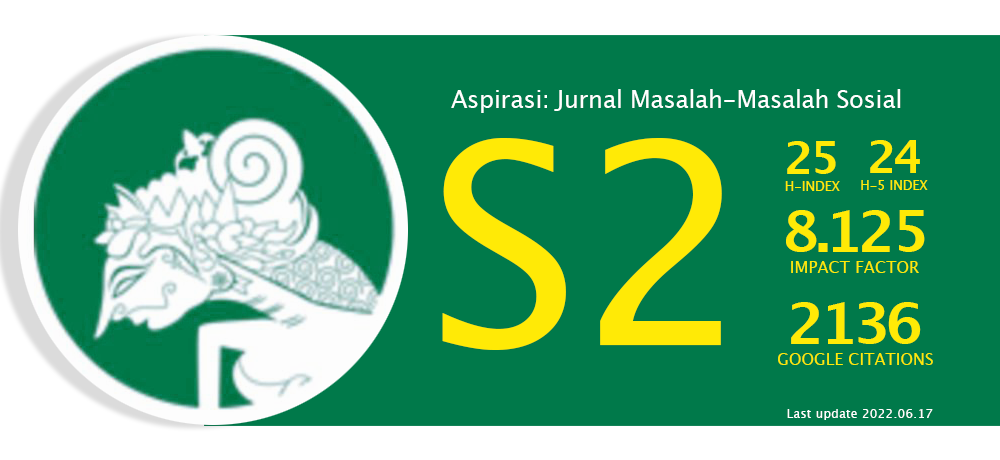Strategi Sistem Jaminan Sosial Nasional Bidang Ketenagakerjaan Dalam Upaya Pelindungan Pekerja Di Kota Surabaya Dan Kota Pekanbaru
Abstract
The background of this research is the institutional transition period of PT Jamsostek to BPJS Ketenagakerjaan (BPJS TK ). The problem is the constraints BPJS TK in their duty to provide labour protection. The methode of this research is qualitative, and the analysis was based on the theory of workers social security. Aims of research are to find out the obstacles and strategy in protecting on workers. The conclusion of researh are: First, the obstacles is Jaminan Hari Tua ( JHT) cash flow chaos of BPJS TK; Second, the low of public awareness on BPJS TK as confusing by BPJS Health; Third, so many rules of the Central Government and Local Government are not in line; and fourth, the lack of the coordination among related agencies.That is why, it was need strategy to protect workers by strengthen the coordination among regulation and related institution.
Latar belakang penelitian ini adalah masa transisi kelembagaan dari PT Jamsostek ke BPJS TK yang mengelola jaminan sosial tenaga kerja. Permasalahannya adalah kendala BPJS TK dalam menjalankan tugasnya memberikan pelindungan kepada tenaga kerja. Metode penelitian ini adalah kualitatif dan analisis didasarkan pada teori jaminan sosial. Tujuan penelitian adalah mengetahui kendala dan strategi SJSN Bidang Ketenagakerjaan dalam upaya pelindungan pekerja. Kesimpulan penelitian adalah: pertama, ketentuan JHT mengakibatkan kekacauan cash flow BPJS TK; kedua, masih rendahnya pemahaman masyarakat terhadap BPJS TK karena rancu dengan BPJS Kesehatan; ketiga, banyaknya aturan pemerintah pusat dan pemerintah daerah yang tidak sejalan; Keempat, kurangnya koordinasi antarinstansi terkait. Oleh karena itu, diperlukan strategi untuk melindungi pekerja melalui penguatan koordinasi antar berbagai regulasi dan lembaga terkait.
Keywords
Full Text:
pdfReferences
Buku
Adi, Isbandi Rukminto. 2008. Komunitas: Pengembangan Masyarakat sebagai Upaya Pemberdayaan Masyarakat. Jakarta: Rajawali Press.
Ashyhadie, Zaeni. 2013. Aspek-Aspek Hukum Jaminan Sosial Tenaga Kerja Indonesia (Edisi Revisi). Jakarta: Rajawali Pers.
Creswell, John W. 2003. Research Design: Qualitative, Quantitative, and Mixed Methods Approaches (Second Edition). California: Sage Publication Inc
Friedlander,Walter A. 1980. Introduction to Social Welfare (5th Ed. New Jersey: Prentice Hall, Inc.
Hendytio, Midelina K. & Babari, J. 1996. ”Pemberdayaan Kelompok Pekerja,” dalam Prijono, Onny S. & Pranarka, A.M.W. (Penyunting). Pemberdayaan, Konsep, Kebijakan dan Implementasi. Jakarta:
CSIS.
Huda, Miftachul. 2009. Pekerjaan Sosial dan Kesejahteraan Sosial: Sebuah Pengantar.Yogyakarta: Pustaka Pelajar.
Husni, Lalu. 2015. Pengantar Hukum Ketenagakerjaan(Edisi Revisi). Jakarta: Rajawali Pers.
Irene-Quiero-Tajalli & Campbell, Craig. 2002. ‘Resilience and Violance at the Macro Level”, dalam Greene, Roberta R., Ed., Resiliency: An Integrated Approach to Practice, Policy, and Research.Washington DC: NAWS Press.
Jordan, Bill. 1998. The New Politics of Welfare. California: Sage Publication, Ltd.
Kirst-Ashman, Karen K. 2007. Introduction to Social Work & Social Welfare: Critical Thinking Perspectives. Second Edition. California: Thomson Higher Education.
Midgley, James. 1995. Social Development: The Developmental Perspective in Social Welfare.London: Sage Publications Ltd.
Nawawie, Hasyim & Nurcholish. 2010. Kekerasan terhadap Pekerja Anak: Perspektif Ilmu Sosial.Yogyakarta: Teras.
Neuman, W. Lawrence. 2006.Social Research Method: Qualitative and Quantitative Approaches (Sixth Edition). USA: Pearson International Edition, Inc.
Patton, Michael Quinn. 2002. Qualitaive Research & Evaluation Methodes (3rd Edition). California: Sage Publication Inc.
Payne, Malcom. 2005. Modern Social Work Theory (3rd Edition). New York: Palgrave MacMillan.
Rubin, Allen & Babbie, Earl R. 2008. Research Methods for Social Work (Sixth Edition International Student Edition). California: Thompson Brooks/Cole.
Silalahi, Uber. 2012. Metode Penelitian Sosial. Bandung:PT Refika Aditama.
Thompson, Neil. 2005. Understanding Social Work: Preparing for Practice. Second Edition. New York: Palgrave MacMillan.
Tunggal, Iman Sjahputra. 2009. Pokok-Pokok Hukum Ketenagaerjaan. Jakarta: Harvarindo.
Wibhawa, Budhi & Raharjo, Santoso T. & Budiarti S., Meilany. 2010. Dasar-Dasar Pekerjaan Sosial.Bandung: Widya Padjadjaran.
Jurnal
Beckmann, Keebet Von Benda. 2014. “Social Security, Personhood, and the State”. Professor Emeritus, Martin Luther University Halle/Wittenberg, and Associate, Department of Law and Anthropology,
Max Planck Institute for Social Anthropology,
Halle, Germany. hlm. 326.
Chopra, Surabhi. 2015. “Legislating Safety Nets: Comparing Recent Social Protection Laws in Asia”. Indiana Journal of Global Legal Studies Vol. 22, #2 (Summer 2015) Indiana University Maurer
School of Law. hlm. 575.
Ramesh, M. 2014. “Social Protection in Indonesia and the Philippines Work in Progress”. Journal of Southeast Asian Economies , Vol. 31, No. 1 (2014), hlm. 40–56 ISSN 2339-5095 print / ISSN 2339-5206 electronic© 2014 JSEAE.
Skripsi
Mahendra, Adya Dwi. 2014. Analisis Pengaruh Pendidikan, Upah, Jenis Kelamin, Usia, dan Pengalaman Kerja terhadap Produktivitas Tenaga Kerja. (Studi di Industri Kecil Tempe di Kota Semarang). Skripsi. Universitas Diponegoro: Fakultas Ekonomi dan Bisnis.
Martini. 2016. Rata-Rata Upah Minimum Provinsi dan Investasi terhadap Penyerapan Tenaga Kerja di Indonesia 2006-2013. Skripsi. Universitas Negeri Yogyakarta: Fakultas Ekonomi.
Peraturan
UU No. 24 Tahun 2011 tentang Badan Penyelenggara Jaminan Sosial.
UU No. 40 Tahun 2004 tentang Sistem Jaminan Sosial Nasional.
UU No. 13 Tahun 2003 tentang Ketenagakerjaan.
UU No. 3 Tahun 1992 tentang Jaminan Sosial Tenaga Kerja.
DOI: https://doi.org/10.46807/aspirasi.v7i2.1286
Refbacks
- There are currently no refbacks.







